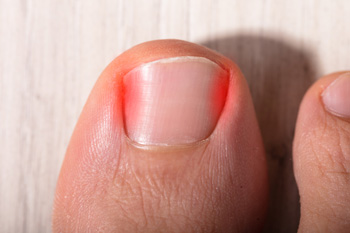Blog
Arthritis and Gout
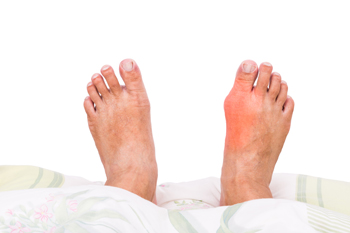 Excess uric acid in the bloodstream may cause crystals to form in the joints of the big toe. This can lead to a condition that is known as gout, which can cause severe pain and discomfort. Gout is considered to be a form of arthritis, and gout attacks have the ability to start and stop suddenly. The affected toe may become inflamed and swollen, and can cause difficulty in walking. There are specific foods that can cause the uric acid levels in your bloodstream to become elevated. These can include shellfish, red meat, and drinks that are made with a large amount of sugar. Research has indicated it is beneficial to implement healthy lifestyle habits into your daily routine, as this may help to prevent gout attacks from occurring. Drinking plenty of fresh water daily, eating fruits and vegetables, and performing gentle stretches may help to ease gout pain. If you are afflicted with gout, it is suggested that you speak to a podiatrist, who can determine the correct course of treatment for you as soon as possible.
Excess uric acid in the bloodstream may cause crystals to form in the joints of the big toe. This can lead to a condition that is known as gout, which can cause severe pain and discomfort. Gout is considered to be a form of arthritis, and gout attacks have the ability to start and stop suddenly. The affected toe may become inflamed and swollen, and can cause difficulty in walking. There are specific foods that can cause the uric acid levels in your bloodstream to become elevated. These can include shellfish, red meat, and drinks that are made with a large amount of sugar. Research has indicated it is beneficial to implement healthy lifestyle habits into your daily routine, as this may help to prevent gout attacks from occurring. Drinking plenty of fresh water daily, eating fruits and vegetables, and performing gentle stretches may help to ease gout pain. If you are afflicted with gout, it is suggested that you speak to a podiatrist, who can determine the correct course of treatment for you as soon as possible.
Gout is a painful condition that can be treated. If you are seeking treatment, contact Dr. Kendall Blackwell from InStride Wilson Podiatry Associates. Our doctor will treat your foot and ankle needs.
What Is Gout?
Gout is a form of arthritis that is characterized by sudden, severe attacks of pain, redness, and tenderness in the joints. The condition usually affects the joint at the base of the big toe. A gout attack can occur at any random time, such as the middle of the night while you are asleep.
Symptoms
- Intense Joint Pain - Usually around the large joint of your big toe, and it most severe within the first four to twelve hours
- Lingering Discomfort - Joint discomfort may last from a few days to a few weeks
- Inflammation and Redness -Affected joints may become swollen, tender, warm and red
- Limited Range of Motion - May experience a decrease in joint mobility
Risk Factors
- Genetics - If family members have gout, you’re more likely to have it
- Medications - Diuretic medications can raise uric acid levels
- Gender/Age - Gout is more common in men until the age of 60. It is believed that estrogen protects women until that point
- Diet - Eating red meat and shellfish increases your risk
- Alcohol - Having more than two alcoholic drinks per day increases your risk
- Obesity - Obese people are at a higher risk for gout
Prior to visiting your podiatrist to receive treatment for gout, there are a few things you should do beforehand. If you have gout you should write down your symptoms--including when they started and how often you experience them, important medical information you may have, and any questions you may have. Writing down these three things will help your podiatrist in assessing your specific situation so that he or she may provide the best route of treatment for you.
If you have any questions, please feel free to contact our office located in Wilson, NC . We offer the newest diagnostic and treatment technologies for all your foot care needs.
How Obesity Can Hurt Your Feet
 Obesity can cause a variety of health problems throughout the entire body. One often overlooked area that is affected by obesity are the feet. Studies have found that general foot pain and plantar heel pain are strongly associated with an increase in body mass index. That is, the higher your weight, the more likely you are to develop pain in your feet. Furthermore, obese individuals are more likely to have flat feet, which can result in strained muscles and ligaments that bring about foot pain. Obese individuals are also at greater risk of developing poor circulation to the feet, peripheral artery disease, and peripheral neuropathy, all of which lead to decreased foot function. A podiatrist can help address concerns regarding your foot health, and provide advice regarding what you can do to improve it.
Obesity can cause a variety of health problems throughout the entire body. One often overlooked area that is affected by obesity are the feet. Studies have found that general foot pain and plantar heel pain are strongly associated with an increase in body mass index. That is, the higher your weight, the more likely you are to develop pain in your feet. Furthermore, obese individuals are more likely to have flat feet, which can result in strained muscles and ligaments that bring about foot pain. Obese individuals are also at greater risk of developing poor circulation to the feet, peripheral artery disease, and peripheral neuropathy, all of which lead to decreased foot function. A podiatrist can help address concerns regarding your foot health, and provide advice regarding what you can do to improve it.
Obesity has become very problematic at this point in time and can have extremely negative effects on the feet. If you’re an obese individual and are concerned about your feet, contact Dr. Kendall Blackwell from InStride Wilson Podiatry Associates. Our doctor can provide the care you need to keep you pain-free and on your feet.
Obesity and Your Feet
Since your feet are what support your entire weight when standing, any additional weight can result in pain and swelling. Being overweight is one of the main contributors to foot complications.
Problems & Complications
Extra Weight – Even putting on just a few extra pounds could create serious complications for your feet. As your weight increases, your balance and body will shift, creating new stresses on your feet. This uneven weight distribution can cause pain, even while doing the simplest tasks, such as walking.
Diabetes – People who are overweight are at serious risk of developing type-2 diabetes, which has a drastic impact on the health of your feet. As you get older, your diabetes might worsen, which could lead to loss of feeling in your feet, sores, and bruises. You could also become more prone to various infections.
Plantar fasciitis – Pressure and stress that is placed on muscles, joints, and tendons can trigger plantar fasciitis, which is an inflammation of tissue that forms along the bottom of the foot.
If you have any questions please feel free to contact our office located in Wilson, NC . We offer the newest diagnostic and treatment technologies for all your foot and ankle needs.
Arthritis Can Cause Pain in the Feet and Ankles
What is a Bunion?
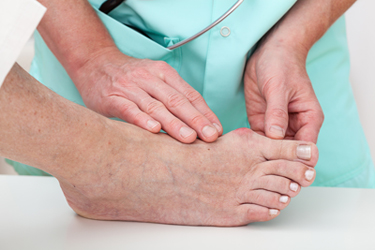 The medical term for a bunion is referred to as hallux valgus. It appears as a bony protrusion that forms on the side of the big toe and may cause wearing shoes to be uncomfortable. The big toe can become misaligned, and may affect the remaining toes. Some of the symptoms that are associated with this condition can include pain, inflammation, and the toe may appear red. If a bunion is left untreated, arthritis may develop, which can cause deeper joint pain. Genetic factors may play a significant role in developing a bunion, in addition to wearing shoes that do not have ample room for the toes to move freely in. If you notice a bump extending from your toe, it is suggested that you consult with a podiatrist who can properly diagnose and treat bunions.
The medical term for a bunion is referred to as hallux valgus. It appears as a bony protrusion that forms on the side of the big toe and may cause wearing shoes to be uncomfortable. The big toe can become misaligned, and may affect the remaining toes. Some of the symptoms that are associated with this condition can include pain, inflammation, and the toe may appear red. If a bunion is left untreated, arthritis may develop, which can cause deeper joint pain. Genetic factors may play a significant role in developing a bunion, in addition to wearing shoes that do not have ample room for the toes to move freely in. If you notice a bump extending from your toe, it is suggested that you consult with a podiatrist who can properly diagnose and treat bunions.
If you are suffering from bunion pain, contact Dr. Kendall Blackwell of InStride Wilson Podiatry Associates. Our doctor can provide the care you need to keep you pain-free and on your feet.
What Is a Bunion?
Bunions are painful bony bumps that usually develop on the inside of the foot at the joint of the big toe. As the deformity increases over time, it may become painful to walk and wear shoes. Women are more likely to exacerbate existing bunions since they often wear tight, narrow shoes that shift their toes together. Bunion pain can be relieved by wearing wider shoes with enough room for the toes.
Causes
- Genetics – some people inherit feet that are more prone to bunion development
- Inflammatory Conditions - rheumatoid arthritis and polio may cause bunion development
Symptoms
- Redness and inflammation
- Pain and tenderness
- Callus or corns on the bump
- Restricted motion in the big toe
In order to diagnose your bunion, your podiatrist may ask about your medical history, symptoms, and general health. Your doctor might also order an x-ray to take a closer look at your feet. Nonsurgical treatment options include orthotics, padding, icing, changes in footwear, and medication. If nonsurgical treatments don’t alleviate your bunion pain, surgery may be necessary.
If you have any questions, please feel free to contact our office located in Wilson, NC . We offer the newest diagnostic and treatment technologies for all your foot care needs.
My Teenager and Sever’s Disease
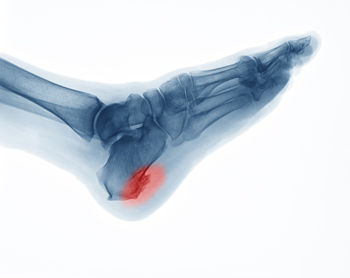 The age group of people who are typically affected by Sever’s disease is between ten and fourteen. It impacts the growth plate in the heel and can cause severe pain and discomfort. It can happen as a result of participating in running and jumping activities, which can exert excess pressure on the heel. It is beneficial to perform stretches that can loosen the Achilles tendon which is connected to the heel. Additionally, many patients wear specific types of footwear that can help in the healing process. If you notice your child is limping or complaining of heel pain, it is strongly suggested that you schedule an appointment with a podiatrist who can diagnose and treat Sever’s disease.
The age group of people who are typically affected by Sever’s disease is between ten and fourteen. It impacts the growth plate in the heel and can cause severe pain and discomfort. It can happen as a result of participating in running and jumping activities, which can exert excess pressure on the heel. It is beneficial to perform stretches that can loosen the Achilles tendon which is connected to the heel. Additionally, many patients wear specific types of footwear that can help in the healing process. If you notice your child is limping or complaining of heel pain, it is strongly suggested that you schedule an appointment with a podiatrist who can diagnose and treat Sever’s disease.
Sever's disease often occurs in children and teens. If your child is experiencing foot or ankle pain, see Dr. Kendall Blackwell from InStride Wilson Podiatry Associates. Our doctor can treat your child’s foot and ankle needs.
Sever’s Disease
Sever’s disease is also known as calcaneal apophysitis, which is a medical condition that causes heel pain I none or both feet. The disease is known to affect children between the ages of 8 and 14.
Sever’s disease occurs when part of the child’s heel known as the growth plate (calcaneal epiphysis) is attached to the Achilles tendon. This area can suffer injury when the muscles and tendons of the growing foot do not keep pace with bone growth. Therefore, the constant pain which one experiences at the back of the heel will make the child unable to put any weight on the heel. The child is then forced to walk on their toes.
Symptoms
Acute pain – Pain associated with Sever’s disease is usually felt in the heel when the child engages in physical activity such as walking, jumping and or running.
Highly active – Children who are very active are among the most susceptible in experiencing Sever’s disease, because of the stress and tension placed on their feet.
If you have any questions, please feel free to contact our office located in Wilson, NC . We offer the newest diagnostic and treatment technologies for all your foot and ankle injuries.
Excessively Sweaty Feet
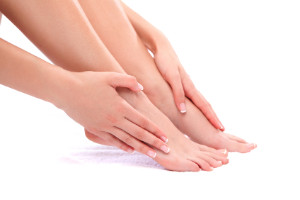 Some people may experience a condition that is referred to as plantar hyperhidrosis. This ailment causes the feet to sweat excessively and can cause discomfort and embarrassment. It can occur as a result of a thyroid disorder, genetic factors, and obesity. In severe cases, sweaty feet may cause shoes to slip off, and dangerous scenarios may happen while driving if the affected foot slips off the brake. Mild cases of plantar hyperhidrosis may be treated with anti-anxiety medication. For more severe cases, surgery may be considered to clip the nerve, and permanently remove it. If you are afflicted with this condition, it is advised that you seek the counsel of a podiatrist who can properly treat plantar hyperhidrosis.
Some people may experience a condition that is referred to as plantar hyperhidrosis. This ailment causes the feet to sweat excessively and can cause discomfort and embarrassment. It can occur as a result of a thyroid disorder, genetic factors, and obesity. In severe cases, sweaty feet may cause shoes to slip off, and dangerous scenarios may happen while driving if the affected foot slips off the brake. Mild cases of plantar hyperhidrosis may be treated with anti-anxiety medication. For more severe cases, surgery may be considered to clip the nerve, and permanently remove it. If you are afflicted with this condition, it is advised that you seek the counsel of a podiatrist who can properly treat plantar hyperhidrosis.
If you are suffering from hyperhidrosis contact Dr. Kendall Blackwell of InStride Wilson Podiatry Associates. Our doctor can provide the care you need to attend to all of your foot and ankle needs.
Hyperhidrosis of the Feet
Hyperhidrosis is a rare disorder that can cause people to have excessive sweating of their feet. This can usually occur all on its own without rigorous activity involved. People who suffer from hyperhidrosis may also experience sweaty palms.
Although it is said that sweating is a healthy process meant to cool down the body temperature and to maintain a proper internal temperature, hyperhidrosis may prove to be a huge hindrance on a person’s everyday life.
Plantar hyperhidrosis is considered to be the main form of hyperhidrosis. Secondary hyperhidrosis can refer to sweating that occurs in areas other than the feet or hands and armpits. Often this may be a sign of it being related to another medical condition such as menopause, hyperthyroidism and even Parkinson’s disease.
In order to alleviate this condition, it is important to see your doctor so that they may prescribe the necessary medications so that you can begin to live a normal life again. If this is left untreated, it is said that it will persist throughout an individual’s life.
A last resort approach would be surgery, but it is best to speak with your doctor to find out what may be the best treatment for you.
If you have any questions please feel free to contact our office located in Wilson, NC . We offer the newest diagnostic and treatment technologies for all your foot and ankle needs.
Running and Stress Fractures
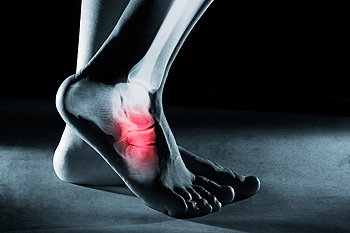 There are five elongated bones that are located in the feet which are known as the metatarsal bones. These bones absorb the impact that occurs as walking and running are done, and as a result, can become fractured. Stress fractures are considered to be hairline fractures and can happen when repetitive activities are frequently performed. Common symptoms of stress fractures include pain, swelling, and bruising. It is beneficial to avoid putting weight on the affected foot as the healing process takes place. It can occur as a result of a sudden change in running, or from eating foods that have insufficient nutrients. The average recovery time is approximately six to eight weeks, and it may help to gradually return to high impact activities. If you are suffering from a stress fracture, it is suggested that you speak with a podiatrist who can determine what the best treatment option is for you.
There are five elongated bones that are located in the feet which are known as the metatarsal bones. These bones absorb the impact that occurs as walking and running are done, and as a result, can become fractured. Stress fractures are considered to be hairline fractures and can happen when repetitive activities are frequently performed. Common symptoms of stress fractures include pain, swelling, and bruising. It is beneficial to avoid putting weight on the affected foot as the healing process takes place. It can occur as a result of a sudden change in running, or from eating foods that have insufficient nutrients. The average recovery time is approximately six to eight weeks, and it may help to gradually return to high impact activities. If you are suffering from a stress fracture, it is suggested that you speak with a podiatrist who can determine what the best treatment option is for you.
Activities where too much pressure is put on the feet can cause stress fractures. To learn more, contact Dr. Kendall Blackwell from InStride Wilson Podiatry Associates. Our doctor can provide the care you need to keep your pain free and on your feet.
Dealing with Stress Fractures of the Foot and Ankle
Stress fractures occur in the foot and ankle when muscles in these areas weaken from too much or too little use. The feet and ankles then lose support when walking or running from the impact of the ground. Since there is no protection, the bones receive the full impact of each step. Stress on the feet can cause cracks to form in the bones, thus creating stress fractures.
What Are Stress Fractures?
Stress fractures occur frequently in individuals whose daily activities cause great impact on the feet and ankles. Stress factors are most common among:
- Runners
- People affected with Osteoporosis
- Tennis or basketball players
- Gymnasts
- High impact workouts
Symptoms
Pain from the fractures occur in the area of the fractures and can be constant or intermittent. It will often cause sharp or dull pain with swelling and tenderness. Engaging in any kind of activity which involves high impact will aggravate pain.
If you have any questions please feel free to contact our office located in Wilson, NC . We offer the newest diagnostic and treatment technologies for all your foot and ankle needs.
Gout Pain Can Be Managed
Possible Reasons an Ingrown Toenail Can Develop
The condition that is known as an ingrown toenail can cause severe pain and discomfort. It occurs as a result of the side of the nail on the big toe growing into the outer edges of the skin. It can happen from trimming the nail incorrectly, or from wearing shoes that do not have ample room for the toes to move freely in. One of the first symptoms that is noticed can be slight swelling and redness on the side of the nail. If this is not treated promptly, it can become infected, and a discharge may ooze from the impacted area. Some patients have found mild relief when the foot is soaked in warm water. This may help the skin surrounding the ingrown toenail to soften, which may make it easier to gently pull the nail away from the skin. If you have developed an ingrown toenail, it is strongly suggested that you consult with a podiatrist who can perform the best treatment for this ailment.
Ingrown toenails may initially present themselves as a minor discomfort, but they may progress into an infection in the skin without proper treatment. For more information about ingrown toenails, contact Dr. Kendall Blackwell of InStride Wilson Podiatry Associates. Our doctor can provide the care you need to keep you pain-free and on your feet.
Ingrown Toenails
Ingrown toenails are caused when the corner or side of a toenail grows into the soft flesh surrounding it. They often result in redness, swelling, pain, and in some cases, infection. This condition typically affects the big toe and may recur if it is not treated properly.
Causes
- Improper toenail trimming
- Genetics
- Improper shoe fitting
- Injury from pedicures or nail picking
- Abnormal gait
- Poor hygiene
You are more likely to develop an ingrown toenail if you are obese, have diabetes, arthritis, or have any fungal infection in your nails. Additionally, people who have foot or toe deformities are at a higher risk of developing an ingrown toenail.
Symptoms
Some symptoms of ingrown toenails are redness, swelling, and pain. In rare cases, there may be a yellowish drainage coming from the nail.
Treatment
Ignoring an ingrown toenail can have serious complications. Infections of the nail border can progress to a deeper soft-tissue infection, which can then turn into a bone infection. You should always speak with your podiatrist if you suspect you have an ingrown toenail, especially if you have diabetes or poor circulation.
If you have any questions, please feel free to contact our office located in Wilson, NC . We offer the newest diagnostic and treatment technologies for all your foot care needs.
Possible Prevention Techniques for Hammertoe
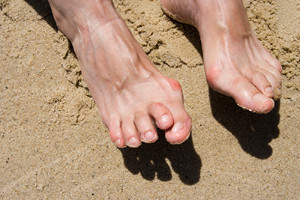 When a hammertoe is observed, it looks like it is bent in an unusual position. It typically affects the second and third toe. The middle joint shifts upward, which forces the toe to bend downward. This condition can happen as a result of genetic factors, wearing shoes that do not have adequate room for the toes to move freely in, or from specific medical conditions. Effective treatment and prevention techniques can include wearing shoes that are large enough to accommodate the hammertoe, and wearing a protective covering over the affected toe. In severe cases, performing surgery may be necessary which can permanently straighten the toes. If you notice signs you may have developed a hammertoe, it is strongly suggested that you are under the care of a podiatrist.
When a hammertoe is observed, it looks like it is bent in an unusual position. It typically affects the second and third toe. The middle joint shifts upward, which forces the toe to bend downward. This condition can happen as a result of genetic factors, wearing shoes that do not have adequate room for the toes to move freely in, or from specific medical conditions. Effective treatment and prevention techniques can include wearing shoes that are large enough to accommodate the hammertoe, and wearing a protective covering over the affected toe. In severe cases, performing surgery may be necessary which can permanently straighten the toes. If you notice signs you may have developed a hammertoe, it is strongly suggested that you are under the care of a podiatrist.
Hammertoe
Hammertoes can be a painful condition to live with. For more information, contact Dr. Kendall Blackwell from InStride Wilson Podiatry Associates. Our doctor will answer any of your foot- and ankle-related questions.
Hammertoe is a foot deformity that affects the joints of the second, third, fourth, or fifth toes of your feet. It is a painful foot condition in which these toes curl and arch up, which can often lead to pain when wearing footwear.
Symptoms
- Pain in the affected toes
- Development of corns or calluses due to friction
- Inflammation
- Redness
- Contracture of the toes
Causes
Genetics – People who are genetically predisposed to hammertoe are often more susceptible
Arthritis – Because arthritis affects the joints in your toes, further deformities stemming from arthritis can occur
Trauma – Direct trauma to the toes could potentially lead to hammertoe
Ill-fitting shoes – Undue pressure on the front of the toes from ill-fitting shoes can potentially lead to the development of hammertoe
Treatment
Orthotics – Custom made inserts can be used to help relieve pressure placed on the toes and therefore relieve some of the pain associated with it
Medications – Oral medications such as anti-inflammatories or NSAIDs could be used to treat the pain and inflammation hammertoes causes. Injections of corticosteroids are also sometimes used
Surgery – In more severe cases where the hammertoes have become more rigid, foot surgery is a potential option
If you have any questions please contact our office located in Wilson, NC . We offer the newest diagnostic and treatment technologies for all your foot and ankle needs.
More...
Are Foot Massages Effective?
 An effective type of foot therapy is a massage. Many patients enjoy the benefits of receiving regular foot massages and are able to observe the benefits it can have on their general health. Certain types of foot pain may be relieved when the feet are gently squeezed, and muscles are stimulated. Muscle spasms may be diminished when pressure is repeatedly exerted on the surrounding tendons and ligaments. Research has indicated blood pressure may be lowered and circulation can improve when frequent foot massages are received. If you would like to learn about additional forms of effective foot therapies, please consult with a podiatrist.
An effective type of foot therapy is a massage. Many patients enjoy the benefits of receiving regular foot massages and are able to observe the benefits it can have on their general health. Certain types of foot pain may be relieved when the feet are gently squeezed, and muscles are stimulated. Muscle spasms may be diminished when pressure is repeatedly exerted on the surrounding tendons and ligaments. Research has indicated blood pressure may be lowered and circulation can improve when frequent foot massages are received. If you would like to learn about additional forms of effective foot therapies, please consult with a podiatrist.
Foot therapy is often necessary for those recovering from either foot deformities or foot injuries. If you have concerns regarding therapy, consult with Dr. Kendall Blackwell from InStride Wilson Podiatry Associates. Our doctor can provide the care you need to keep you pain-free and on your feet.
Most Common Injuries
People who are active or athletes are prone to a variety of injuries. Therefore, it is often important to take part in physical therapy in order to quickly get back on the right track.
What to Do When Injured
Physical Therapy – This specialized treatment will focus on the affected area, speeding up recovery and the overall healing process. It is a proven method that has helped millions of people return from any injury.
During physical therapy you will undergo regimented training to get back into full form. Training is often very difficult, especially at first when the foot feels weak. Physical therapy often involves:
Basic stretching and twisting exercises – getting the feet’s mobility and flexibility up.
Massaging – the therapist will massage the injured area in order to activate the muscles and relax them.
Strengthening Exercises – this allows the muscles in the affected area to regain their full strength, a vital step towards full recovery.
If you have any questions please feel free to contact our office located in Wilson, NC . We offer the newest diagnostic tools and technology to treat your foot and ankle needs.
What to Expect If You Have Broken Your Toe
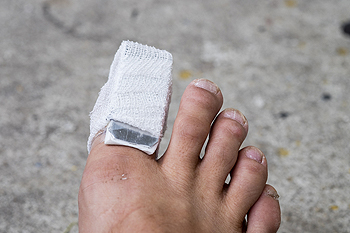 If your toe bone has broken into one or more pieces, you have experienced a broken toe. A broken toe can often be mistaken for a toe sprain, however during this type of injury, you may actually hear the bone break. If left untreated, a broken toe can alter your walking or running, and leave you in a great deal of pain. Common symptoms that often accompany a broken toe may include throbbing pain, swelling, bruising or discoloration of the surrounding skin, dislocation of the toe, and difficulty bearing weight on the affected toe. Stubbing the toe, or having an object dropped on it, are the most common causes of a broken toe. To treat a broken toe, a podiatrist may recommend a splint to help support the toe, or surgery for more severe cases. In order to distinguish a toe break from a sprain, it’s suggested you consult with a podiatrist for professional care and a proper diagnosis.
If your toe bone has broken into one or more pieces, you have experienced a broken toe. A broken toe can often be mistaken for a toe sprain, however during this type of injury, you may actually hear the bone break. If left untreated, a broken toe can alter your walking or running, and leave you in a great deal of pain. Common symptoms that often accompany a broken toe may include throbbing pain, swelling, bruising or discoloration of the surrounding skin, dislocation of the toe, and difficulty bearing weight on the affected toe. Stubbing the toe, or having an object dropped on it, are the most common causes of a broken toe. To treat a broken toe, a podiatrist may recommend a splint to help support the toe, or surgery for more severe cases. In order to distinguish a toe break from a sprain, it’s suggested you consult with a podiatrist for professional care and a proper diagnosis.
Broken toes may cause a lot of pain and should be treated as soon as possible. If you have any concerns about your feet, contact Dr. Kendall Blackwell from InStride Wilson Podiatry Associates. Our doctor will treat your foot and ankle needs.
What Is a Broken Toe?
A broken toe occurs when one or more of the toe bones of the foot are broken after an injury. Injuries such as stubbing your toe or dropping a heavy object on it may cause a toe fracture.
Symptoms of a Broken Toe
- Swelling
- Pain (with/without wearing shoes)
- Stiffness
- Nail Injury
Although the injured toe should be monitored daily, it is especially important to have a podiatrist look at your toe if you have severe symptoms. Some of these symptoms include worsening or new pain that is not relieved with medication, sores, redness, or open wounds near the toe.
If you have any questions, please feel free to contact our office located in Wilson, NC . We offer the newest diagnostic and treatment technologies for all your foot care needs.
How Changes in Your Feet Can Indicate Problems Elsewhere
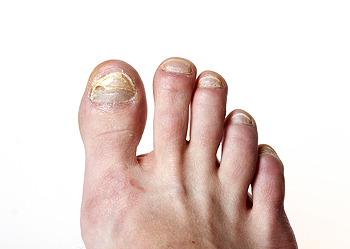 Believe it or not, many illnesses are often initially detected by podiatrists. Our feet can hint at a variety of issues that are occurring throughout the rest of our bodies. For example, problems with blood circulation can cause the feet to change color or feel cold. Simple toenail discoloration can indicate diseases such as diabetes, heart disease, and lung disease. A podiatrist can also tell if toenail discoloration is actually a bacterial or fungal infection. Various kidney diseases can be shown in the feet through ankle swelling or toenail discoloration. Therefore, when experiencing unknown symptoms in the feet, it is important that you consult with a podiatrist to make sure that these symptoms are not indicating a more serious, underlying condition.
Believe it or not, many illnesses are often initially detected by podiatrists. Our feet can hint at a variety of issues that are occurring throughout the rest of our bodies. For example, problems with blood circulation can cause the feet to change color or feel cold. Simple toenail discoloration can indicate diseases such as diabetes, heart disease, and lung disease. A podiatrist can also tell if toenail discoloration is actually a bacterial or fungal infection. Various kidney diseases can be shown in the feet through ankle swelling or toenail discoloration. Therefore, when experiencing unknown symptoms in the feet, it is important that you consult with a podiatrist to make sure that these symptoms are not indicating a more serious, underlying condition.
When dealing with systemic disease of the feet, it is extremely important to check the affected areas routinely so that any additional problems are caught quickly. If you have any concerns about your feet and ankles contact Dr. Kendall Blackwell from InStride Wilson Podiatry Associates. Our doctor will assist you with all of your podiatric needs.
Systemic Diseases of the Feet
Systemic diseases affect the whole body, and symptoms usually are displayed in the feet. This condition can make a patient’s ability to walk unbearable. Systemic diseases include gout, diabetes mellitus, neurological disorders, and arthritis.
Gout – is caused by an excess of uric acid in the body. Common symptoms include pain, inflammation, and redness at the metatarsal/phalangeal joint of the base big toe. Gout can be treated by NSAIDs to relieve pain and inflammation, and other drugs that lower the acid levels in the body.
Diabetes mellitus – is an increase in the level of blood sugar that the body cannot counteract with its own insulin. Failure to produce enough insulin is a factor in Diabetes.
Diabetes of the Feet
Diabetic Neuropathy – may lead to damaged nerves and affect the feet through numbness and loss of sensation.
Peripheral Vascular Disease – can restrict the blood flow to the feet, and often times lead to amputation of the feet.
If you have any questions please feel free to contact our office located in Wilson, NC . We offer the newest diagnostic and treatment technologies for all your foot and ankle needs.


